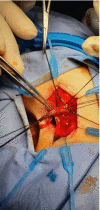Early Diagnosis of Anal Canal Duplication: The Importance of a Physical Examination
- PMID: 35719790
- PMCID: PMC9199309
- DOI: 10.7759/cureus.25040
Early Diagnosis of Anal Canal Duplication: The Importance of a Physical Examination
Abstract
Anal canal duplication (ACD) is an extremely rare congenital anomaly of the intestinal tract that presents as an extra opening of the anal canal without communication with the anorectum. We present the case of a five-year-old male presenting to the pediatrician without symptoms and upon physical examination, a duplicated anal canal along the midline was discovered. The patient was admitted for surgery and the canal was removed via mucosal stripping. Postoperatively, the patient recovered well. The present study aims to expand on our knowledge of a very rare pathological entity and emphasize the importance of a complete pediatric physical examination.
Keywords: anal canal duplication; ano rectal diseases; anorectal malformation; congenital disease; neonatal malformation.
Copyright © 2022, Karamatzanis et al.
Conflict of interest statement
The authors have declared that no competing interests exist.
Figures







Similar articles
-
Anal Canal Duplication in a 25-Year-Old Female Patient.Cureus. 2023 Mar 22;15(3):e36516. doi: 10.7759/cureus.36516. eCollection 2023 Mar. Cureus. 2023. PMID: 37090320 Free PMC article.
-
Anal canal duplication.Eur J Pediatr. 2010 May;169(5):633-5. doi: 10.1007/s00431-009-1094-x. Epub 2009 Oct 25. Eur J Pediatr. 2010. PMID: 19856187
-
Anal Canal Duplication in an Adult Female-Case Report and Pathology Guiding.Medicina (Kaunas). 2021 Nov 4;57(11):1205. doi: 10.3390/medicina57111205. Medicina (Kaunas). 2021. PMID: 34833422 Free PMC article.
-
Anal Canal Duplication Mimicking Recurrent Abscess: A Case Report and Review of the Literature.Front Surg. 2022 May 12;9:908390. doi: 10.3389/fsurg.2022.908390. eCollection 2022. Front Surg. 2022. PMID: 35647015 Free PMC article. Review.
-
Anal duplication: is surgery indicated? A report of three cases and review of the literature.Pediatr Surg Int. 2019 Sep;35(9):971-978. doi: 10.1007/s00383-019-04509-x. Epub 2019 Jun 29. Pediatr Surg Int. 2019. PMID: 31256296 Review.
Cited by
-
Anal Canal Duplication in a 25-Year-Old Female Patient.Cureus. 2023 Mar 22;15(3):e36516. doi: 10.7759/cureus.36516. eCollection 2023 Mar. Cureus. 2023. PMID: 37090320 Free PMC article.
-
Anal canal duplication with heterotopic gastric mucosa and anal stenosis: first case report and literature review.Front Pediatr. 2024 Sep 5;12:1452116. doi: 10.3389/fped.2024.1452116. eCollection 2024. Front Pediatr. 2024. PMID: 39301039 Free PMC article.
References
-
- Duplicated proctodeum. Vietan D, Patel RV, Huddart SN. Pediatr Surg Int. 2009;25:535–536. - PubMed
-
- Anal-canal duplication in a 6-year-old child. Ochiai K, Umeda T, Murahashi O, Sugitoh T. Pediatr Surg Int. 2002;18:195–197. - PubMed
-
- Normal and abnormal development of the anorectum. Van der Putte SC. J Pediatr Surg. 1986;21:434–440. - PubMed
-
- Normal and abnormal embryonic development of the anorectum in human embryos. Nievelstein RA, van der Werff JF, Verbeek FJ, Valk J, Vermeij-Keers C. Teratology. 1998;57:70–78. - PubMed
Publication types
LinkOut - more resources
Full Text Sources
